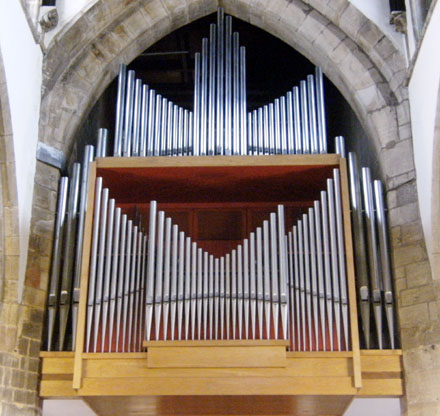
 |
Cumbrian Society of Organists |
Six members joined Andy Plowman (also a CSO member) at Kendal Parish Church. Andy explained the history of the several organs which had been used in the church since the early 17th century. ‘Father Smith’ installed an organ in place of its predecessor in the West Gallery in 1702. After several interventions this instrument was placed at floor level in front of the west door in 1846 when the gallery was removed. There is still no footpath to the west door in the grounds as a legacy of the period when the west door entrance was blocked by the organ. 1852 saw the organ moved again for a sojourn in the Bellingham Chapel. In 1877 the ‘Father Smith’ was removed to St. Cuthbert’s Church in Darwen where its casework is believed to remain.
The replacement organ, also installed in 1877, was built by Henry Willis. It was enlarged in 1905 and again in 1949 when preparations were made for a fourth manual. The positioning of the instruments in the Bellingham Chapel was apparently not particularly successful and, when the church interior was reorganised in 1969, the organ was again rebuilt by J W Walker and Sons; this time as a 3 manual instrument positioned at the west end of the church beneath the tower. Modifications were made in 1987 by Holmes and Swift.
Andy noted that the tower had been beset by chronic problems of rainwater ingress which had impacted on the ‘Walker’ organ, most recently affecting the pedal division, some of which was not currently serviceable. Repairs to the tower are proposed and these will require removal of the Walker organ. It is hoped this will allow refurbishment of the instrument, with some limited alterations, prior to reinstallation in its current position.
Over the years the Kendal choir stalls had been positioned at several locations, including the west end of the church. In 2002 a ‘Bevington’ organ was installed to accompany the choir which now returned to the east end of the church. The instrument was originally built in 1874 for Greasbrough in South Yorkshire and, following redundancy at that location, had been in temporary use at St Asaph Cathedral before a period of storage with Woods of Huddersfield.
Andy followed his talk with a demonstration of both organs, playing pieces by Stanley, Jongen, Buxtehude and Howells. This showed the wide range of colours achievable on the ‘Walker’ instrument, and the fine quality of the Bevington, (albeit interrupted briefly by the overwhelming sound of torrential downpours beating on the church roof!). Members then had ample opportunity to play on both instruments.
Many thanks to Andy for his hospitality throughout the visit.


Holy Trinity Church, Kendal, Main Organ
Holy Trinity Church, Kendal, Chancel Organ